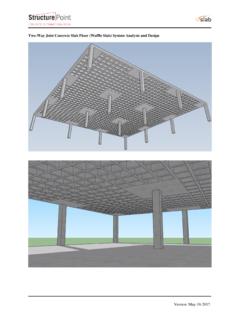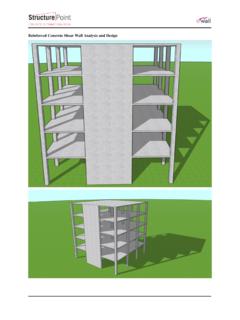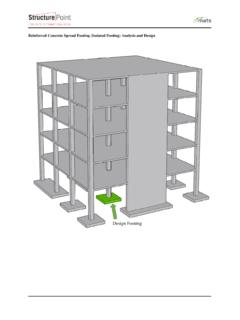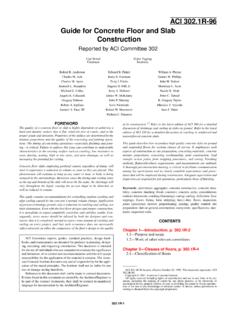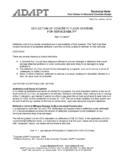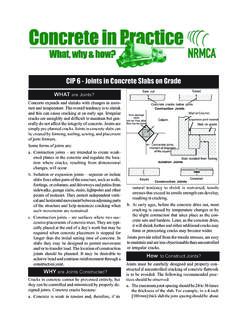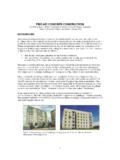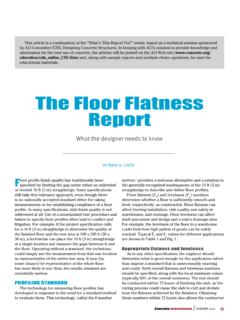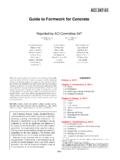Transcription of One-Way Wide Module Joist Concrete Floor Design
1 1 One-Way wide Module Joist Concrete Floor Design 32'32'32'32'30'-0"30'-0"30'-0"124AB20" 20" (typ.)24" 24" (typ.)332'CDEF Figure 1 One-Way wide Module Joist Concrete Floor Framing System 2 Overview A typical Floor plan of a 5-story office building located in Los Angeles, CA is shown in Figure 1. The wide - Module Joist Floor system with special reinforced Concrete shear walls is selected as the structural system. As the building is assigned to the Seismic Design Category D, building frame is to be designed to resist the gravity loads only and the lateral load effects are resisted by the shear walls. 6 ft Module with 66 in. pan width and 6 in. rib width shall be utilized. Code Building Code Requirements for Structural Concrete (ACI 318-11) and Commentary (ACI 318R-11) Minimum Design Loads for Buildings and Other Structures (ASCE/SEI 7-10) International Code Council, 2009 International Building Code, Washington, , 2009 Design Data Floor Heights: Typical Floor -to- Floor Height 12 ft First Story Height 16 ft Material Properties: Concrete : Unit weight of normal weight Concrete , 150wc pcf, Specified compressive strength, 5000'fc psi Reinforcing Steel: Specified yield strength of reinforcement, 60000fy psi, Specified yield strength of transverse reinforcement, 60000fyt psi Loads: Dead Loads Self-weight is to be determined.
2 Superimposed dead load, 20 psf (Typical Floor levels only) Live Loads Minimum uniformly distributed live loads, Lo, and minimum concentrated live loads are given in ASCE/SEI 7-10, Table 4-1. Typical Floor Level, Live load, 80Lo psf (Average value of 80 psf is considered by inspection of Table 4-1 for Office Buildings) Minimum concentrated live load of 2000 lb uniformly distributed over an area of ft2 needs to be located so as to produce the maximum load effects in the structural members per ASCE/SEI 7-10, For simplicity, this requirement is not considered in this example. Roof Live Load, 20Lo psf (Ordinary flat roofs) Required fire resistance rating = 2 hours 3 Solution 1. PRELIMINARY SIZING Determine the preliminary slab and Joist sizes for 6 -0 wide - Module Joist system One-Way Slab In lieu of detailed calculation for the deflections, ACI 318 gives minimum thickness for One-Way slabs in Table (a).
3 End Spans: in Interior Spans: in The slab thickness for wide - Module joists is generally governed by the fire rating. From IBC 2009, Table (3), for 2-hour fire rating, the minimum slab thickness is in. Therefore, select slab thickness as 5 in for all spans. One-Way Joist Since the wide - Module Joist systems do not meet the limitations of ACI 318, through , the structural members of this type of Joist construction shall be designed as slabs and beams as stated in ACI 318, In lieu of detailed calculation for the deflections, ACI Code gives minimum thickness for non-prestressed beams in Table (a). End Span: in (governs) Interior Span: in Therefore, select pan depth of 16 in. which makes the total Joist depth as 21 in. Determine the preliminary column sizes for 6 -0 wide - Module Joist system Interior Columns Select a preliminary size based on the axial load demand.
4 Therefore, the load take-down for an interior column is done as follows: The governing load combination: where D = Dead Load; L= Live Load; Lr= Roof Live Load Typical Floor Level Loads No. of Floors 4 Dead Loads, D Self-weight of wide - Module Joist system (16 + 6 + 66) 497 plf (From CRSI Design Handbook 2008, Table 8-3(b). This is equal to psf. Superimposed dead load 20 psf Live Load, L: Calculate the live load reduction per ASCE/SEI 7-10, section ) (LLTLLo A S C E / S E I 7 - 1 0 , E q ( 4 - 1 ) 4 where Lreduced Design live load per ft2 of area supported by the member oLunreduced Design live load per ft2 of area supported by the member LLKlive load element factor (ASCE 7-10, Table 4-2) TAtributary area in ft2 Tributary Area 960)"0'32"0'30(AT ft2 80Lo psf ) (80L psf which satisfies requirement for members supporting two or more floors per ASCE/SEI 7-10, section Roof Level Loads Dead Loads, D Self-weight of wide - Module Joist system (16 + 6 + 66) 497 plf (From CRSI Design Handbook 2008, Table 8-3(b).))
5 This is equal to psf. No superimposed dead load at the roof Roof Live Load, Lr: Calculate the roof live load reduction per ASCE/SEI 7-10, section 21orRRLL where 20L12r ASCE/SEI 7-10, Eq (4-2) 20Lo psf since 960AT ft2 600 ft2 1R2 for flat roof psf Total Factored Load on 1st story interior column (@ 1st interior support) Total Floor Load kips Total Roof Load kips Assume 24 in square column with 4 No. 11 vertical bars with Design axial strength, max,nP of stystgcmax,nAfAA' ,n lb 1454 Pmax,n kips Column Self-weight kips Total Reaction @ 1st interior support kips 1454 kips. Therefore, the interior column size of 24x24 is adequate. By utilizing the same procedure as outlined above, it is concluded that for the edge and corner columns 20x20 size shall be adequate. 5 2. Design OF STRUCTURAL MEMBERS Thedesign of the following structural members shall be performed: One-Way slab One-Way Joist Interior Beam Spandrel Beam Interior Column The computer program solutions shall also be represented for each structural member listed above.
6 One-Way Slab Design The typical Floor slab Design shall be performed. The slab is spanning between joists and designed to carry gravity loads. The unit strip of 1 ft shall be considered in the Design . Note that ACI 318 does not allow live load reduction for One-Way slabs. Figure Partial plan view illustrating slab Design strip 6 The Design involves the following steps: Determination of span loads Determination of Design moments and shears Flexural Design Shear Design Deflections Computer Program Solution Summary and comparison of Design results Conclusions and observations Determination of span loads ACI 318, gives the following load combinations for structural members loaded with dead and live loads: A C I 3 1 8 , E q . 9 - 1 A C I 3 1 8 , E q . 9 - 2 Factored total load per Eq.
7 9-1 klf per ft Factored total load per Eq. 9-2 klf per ft The span loads are governed by load combination per Eq. 9-2. Determination of Design moments and shears Using the approximate coefficients of ACI 318, , the factored moments, and shears are determined and summarized in the Tables , and respectively below. Table One-Way Slab Design Moments Location Design Moment Value End Spans Exterior Support Negative ft-kips/ft Mid-span Positive ft-kips/ft Interior Support Negative ft-kips/ft Interior Spans Mid-span Positive ft-kips/ft Support Negative ft-kips/ft 7 Table One-Way Slab Design Shears Location Design Shear Value End Span at Face of First Interior Support kips/ft At Face of all other Supports kips/ft Flexural Design For the One-Way slab of a wide - Module Joist system, single layer longitudinal reinforcement is to be provided.
8 The first interior support negative moment governs the Design as tabulated in Table Therefore, it is favorable to place the single layer reinforcement closer to the top fiber of the Concrete . The required reinforcement shall be calculated for the first interior support negative moment first. The required reinforcement for the end span positive moment shall also be calculated as the low effective depth due to the reinforcement location may govern the required reinforcement amount. Finally, the required reinforcement for Design shall be checked against the shrinkage and temperature reinforcement requirement per ACI 318, Calculate the required reinforcement to resist the first interior support negative moment: ft-kips/ft Assume tension-controlled section ( ). Note that this assumption shall be verified within the calculations below. Unit strip width, 12b in The One-Way slab reinforcement is to be placed on top of the One-Way Joist top reinforcement.
9 Assuming No. 3 bars for both the slab and wide - Module Joist stirrups and following the 11/2 Concrete cover to reinforcement requirement of beam stirrups per ACI 318, , the distance from extreme compression fiber to the centroid of longitudinal tension reinforcement, d, is calculated below: in Since we are designing a slab ( wide compression zone), select a moment arm, jd approximately equal to Assume that in. Required reinforcement @ initial trial, , , in2/ft Use one-iteration to refine this value by inserting it in the equation that finds the depth of the equivalent stress block. Depth of equivalent stress block, , , in. Neutral axis depth, in. 8 Strain at tensile reinforcement, ) ( ) (tt Therefore, the section is tension-controlled. Use the value of a,) ( , to get an improved value for As. ) (000, , )2ad(fyMAus in2/ft Calculate the required reinforcement to resist the positive moment ft-kips/ft Assume tension-controlled section ( ).
10 Note that this assumption shall be verified within the calculations below. Unit strip width, 12b in The distance from extreme compression fiber to the centroid of longitudinal tension reinforcement in. Since we are designing a slab ( wide compression zone), select a moment arm, jd approximately equal to Assume that in. Required reinforcement @ initial trial, , , in2/ft Use one-iteration to refine this value by inserting it in the equation that finds the depth of the equivalent stress block. Depth of equivalent stress block, , , in. Neutral axis depth, in. Strain at tensile reinforcement, ) ( ) (tt Therefore, the section is tension-controlled. Use the value of a,) ( , to get an improved value for As. ) (000, , )2ad(fyMAus in2/ft The required reinforcement from analysis is in2/ft. In this example, positive moment value controls the Design due to the placement of slab reinforcement near top Concrete surface even though it is not the governing Design moment for the slab.
